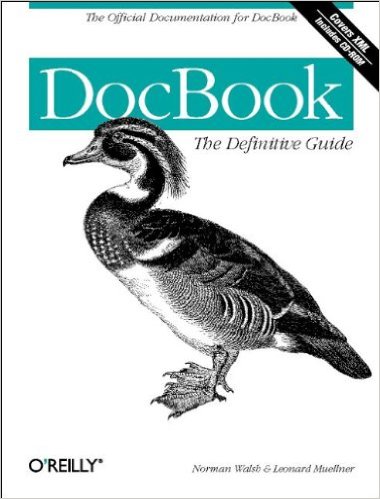
DocBook: The Definitive Guide
The official documentation for the DocBook DTD. Designed to be the clear, concise, normative reference to the DocBook DTD.
Tag(s): Digital Libraries
Publication date: 07 Dec 1999
ISBN-10: 1565925807
ISBN-13: 9781565925809
Paperback: 652 pages
Views: 17,764
Type: N/A
Publisher: O’Reilly Media, Inc.
License: GNU Free Documentation License
Post time: 08 Mar 2007 12:49:14
DocBook: The Definitive Guide
 The official documentation for the DocBook DTD. Designed to be the clear, concise, normative reference to the DocBook DTD.
The official documentation for the DocBook DTD. Designed to be the clear, concise, normative reference to the DocBook DTD.
Tag(s):
Digital Libraries
Publication date: 07 Dec 1999
ISBN-10: 1565925807
ISBN-13: 9781565925809
Paperback: 652 pages
Views: 17,764
Document Type: N/A
Publisher: O’Reilly Media, Inc.
License: GNU Free Documentation License
Post time: 08 Mar 2007 12:49:14
Publication date: 07 Dec 1999
ISBN-10: 1565925807
ISBN-13: 9781565925809
Paperback: 652 pages
Views: 17,764
Document Type: N/A
Publisher: O’Reilly Media, Inc.
License: GNU Free Documentation License
Post time: 08 Mar 2007 12:49:14
Summary/Excerpts of (and not a substitute for) the GNU Free Documentation License:
Permission is granted to copy, distribute and/or modify this document under the terms of the GNU Free Documentation License, Version 1.3 or any later version published by the Free Software Foundation; with no Invariant Sections, no Front-Cover Texts, and no Back-Cover Texts. A copy of the license is included in the section entitled "GNU Free Documentation License".
Click here to read the full license.
Click here to read the full license.
Terms and Conditions:
Book Summary:
The DocBook SGML specification allows publishers to mark up text content to be used in traditional print as well as on the Web. DocBook: The Definitive Guide examines and catalogs the entirety of the DocBook specification and will be useful to anyone who uses SGML to publish documents.
DocBook uses SGML to structure the contents of a book, identifying such elements as authors, chapters, headings, and so on. The heart of DocBook: The Definitive Guide lies in its full reference of over 300 DocBook elements, organized alphabetically (from "Abbrev" to "Year"). The syntax of each element is described, along with sample SGML code illustrating its proper usage.
This book assumes a working knowledge of SGML, though basic concepts are described during the introduction. Later reference sections present a wide range of DocBook "entities." (These are values that can be used to describe custom content within a DocBook document.) Character entities, codes used to describe diacritics and mathematical symbols, are also listed.
Later sections address DocBook customization, including removal of unused elements. As you might expect, no single publishing scheme employs every SGML element available; however, like any good reference, it includes a discussion of each element that could conceivably be used. Another useful section discusses the relationship between DocBook and XML, including the fairly simple conversion possibilities for cross-translating these markup types.
Norman Walsh wrote:Permission is granted to copy, distribute and/or modify this document under the terms of the GNU Free Documentation License, as spelled out in the book's legal notice.
Book Summary:
The DocBook SGML specification allows publishers to mark up text content to be used in traditional print as well as on the Web. DocBook: The Definitive Guide examines and catalogs the entirety of the DocBook specification and will be useful to anyone who uses SGML to publish documents.
DocBook uses SGML to structure the contents of a book, identifying such elements as authors, chapters, headings, and so on. The heart of DocBook: The Definitive Guide lies in its full reference of over 300 DocBook elements, organized alphabetically (from "Abbrev" to "Year"). The syntax of each element is described, along with sample SGML code illustrating its proper usage.
This book assumes a working knowledge of SGML, though basic concepts are described during the introduction. Later reference sections present a wide range of DocBook "entities." (These are values that can be used to describe custom content within a DocBook document.) Character entities, codes used to describe diacritics and mathematical symbols, are also listed.
Later sections address DocBook customization, including removal of unused elements. As you might expect, no single publishing scheme employs every SGML element available; however, like any good reference, it includes a discussion of each element that could conceivably be used. Another useful section discusses the relationship between DocBook and XML, including the fairly simple conversion possibilities for cross-translating these markup types.
Tweet
About The Author(s)
No information is available for this author.
Book Categories
Computer Science
Introduction to Computer Science
Introduction to Computer Programming
Algorithms and Data Structures
Artificial Intelligence
Computer Vision
Machine Learning
Neural Networks
Game Development and Multimedia
Data Communication and Networks
Coding Theory
Computer Security
Information Security
Cryptography
Information Theory
Computer Organization and Architecture
Operating Systems
Image Processing
Parallel Computing
Concurrent Programming
Relational Database
Document-oriented Database
Data Mining
Big Data
Data Science
Digital Libraries
Compiler Design and Construction
Functional Programming
Logic Programming
Object Oriented Programming
Formal Methods
Software Engineering
Agile Software Development
Information Systems
Geographic Information System (GIS)
Mathematics
Mathematics
Algebra
Abstract Algebra
Linear Algebra
Number Theory
Numerical Methods
Precalculus
Calculus
Differential Equations
Category Theory
Proofs
Discrete Mathematics
Theory of Computation
Graph Theory
Real Analysis
Complex Analysis
Probability
Statistics
Game Theory
Queueing Theory
Operations Research
Computer Aided Mathematics
Supporting Fields
Web Design and Development
Mobile App Design and Development
System Administration
Cloud Computing
Electric Circuits
Embedded System
Signal Processing
Integration and Automation
Network Science
Project Management
Operating System
Programming/Scripting
Ada
Assembly
C / C++
Common Lisp
Forth
Java
JavaScript
Lua
Rexx
Microsoft .NET
Perl
PHP
R
Python
Rebol
Ruby
Scheme
Tcl/Tk
Miscellaneous
Sponsors